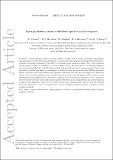Open population maximum likelihood spatial capture-recapture
Abstract
Open population capture‐recapture models are widely used to estimate population demographics and abundance over time. Bayesian methods exist to incorporate open population modeling with spatial capture‐recapture (SCR), allowing for estimation of the effective area sampled and population density. Here, open population SCR is formulated as a hidden Markov model (HMM), allowing inference by maximum likelihood for both Cormack‐Jolly‐Seber and Jolly‐Seber models, with and without activity center movement. The method is applied to a 12‐year survey of male jaguars (Panthera onca) in the Cockscomb Basin Wildlife Sanctuary, Belize, to estimate survival probability and population abundance over time. For this application, inference is shown to be biased when assuming activity centers are fixed over time, while including a model for activity center movement provides negligible bias and nominal confidence interval coverage, as demonstrated by a simulation study. The HMM approach is compared with Bayesian data augmentation and closed population models for this application. The method is substantially more computationally efficient than the Bayesian approach and provides a lower root‐mean‐square error in predicting population density compared to closed population models.
Citation
Glennie , R , Borchers , D L , Murchie , M , Harmsen , B J & Foster , R J 2019 , ' Open population maximum likelihood spatial capture-recapture ' , Biometrics , vol. 75 , no. 4 , pp. 1345-1355 . https://doi.org/10.1111/biom.13078
Publication
Biometrics
Status
Peer reviewed
ISSN
0006-341XType
Journal article
Description
Funding: Part-funded by UK EPSRC grant EP/K041061/1 (DB); Richard Glennie was funded by the Carnegie Trust.Collections
Items in the St Andrews Research Repository are protected by copyright, with all rights reserved, unless otherwise indicated.

